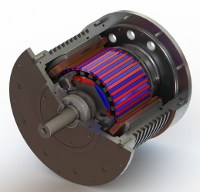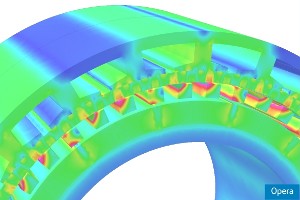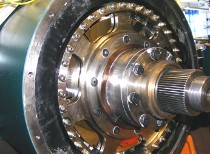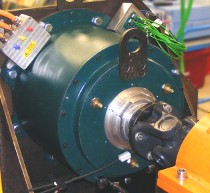 |
| June 19, 2012 | Volume 08 Issue 23 |
Designfax weekly eMagazine
Archives
Partners
Manufacturing Center
Product Spotlight
Modern Applications News
Metalworking Ideas For
Today's Job Shops
Tooling and Production
Strategies for large
metalworking plants
Magnetic gears get 3D sim for direct-drive, in-wheel electric motors

Opera electromagnetic simulation is helping Magnomatics commercialize a breakthrough vehicular direct-drive technology that integrates a permanent magnet motor with non-contact magnetic gearing.
An innovative electromagnetic simulation tool is speeding the commercialization of a breakthrough direct-drive technology for electric vehicles by U.K.-based Magnomatics. The Opera simulator (Cobham Technical Services; Aurora, IL ) has been used by Magnomatics – a company that was set up to develop new forms of magnetic power transmission – to design a novel direct-drive system that integrates a permanent magnet motor with non-contact magnetic gearing.
Called the Pseudo Direct Drive, this new form of traction motor offers such an exceptional torque density that it can even be packaged within a vehicle's wheel. The technology has already been demonstrated on a 22-in. city-bus wheel, where it generated a continuous rated torque of 4,000 Nm and speeds up to 750 rpm – which equates to a top speed of around 80 km/hr. Magnomatics is now engaged in several other Pseudo Direct Drive design projects in areas including marine propulsion, defense vehicles, and direct-drive electricity generators for wind turbines.
A magnetic gear uses permanent magnets to transmit torque between an input and output shaft without mechanical contact (see video below). Torque densities comparable with mechanical gears can be achieved with an efficiency of greater than 99% at full load, and with much higher part-load efficiencies than mechanical gearboxes. For very high power ratings, a magnetic gear will be smaller and lighter than a mechanical gear. Because there is no mechanical contact between the moving parts, there is no friction and wear, so lubrication is not required, and noise and vibration is reduced. Magnetic gears also inherently protect against overloads by harmlessly slipping if an overload torque is applied.
The design concepts behind Pseudo Direct Drive have emerged from a major design exercise by Magnomatics' design team, which evaluated thousands of design variations with the aid of automated simulation provided by Cobham Technical Services' Opera software.
Opera's finite element modeling, simulation, post-processing, and optimization toolchain features a scripting language that allows users to automate their virtual design processes. Using this feature, Magnomatics has built up an extensive library of magnetic gear and motor/generator design utilities that allow its engineering users to rapidly investigate new powertrain concepts. These tools provide proven and easy-to-modify design shapes for the component parts of its magnetic gearing and motor/generator systems, such as stators and rotors, as well as special post-processing routines that provide proprietary analyses of the resulting performance.
Typically, Magnomatics uses Opera scripts to evaluate hundreds of design variations before homing in on shapes and geometries that offer the best performance. These initial design exercises are performed using Opera in a two-dimensional mode, where the simulations only take a few seconds each. Then, once the most promising design concepts have been identified, Magnomatics switches to Opera's three-dimensional (3D) simulation mode to evaluate a small number of potential design solutions in depth.

Opera-based electromagnetic simulation of part of the motor and power transmission system.
This extensive simulation phase is critical for Magnomatics because its major design goals, such as the need to reduce the amounts of magnetic material while optimizing torque, compete strongly against each other. Building lots of prototypes would simply take too long and be far too expensive.
During the final, virtual 3D prototyping phase, Opera's speed of execution is critical, as the complete drive system has to be simulated. With motors and generators, it's often possible to reduce the complexity by modeling and simulating just a segment of the radial design, as the shape is symmetrical. However, Magnomatics' magnetic gearing designs have little or no symmetry that allow the scale of the computation to be reduced.
"Opera underpins a lot of our development work," says Magnomatics' research director, Dr. Richard Clark. "We are a highly design-centric organization, and the package's design automation capability has been critical in helping us to work on so many magnetic power transmission projects."

A view of the interior of the magnetic gearing system inside Magnomatics' Pseudo Direct Drive.
Dr Clark also praises Cobham's support for its customers, as the company optimized Opera for its magnetic power transmission design by adding a feature that allows the tool to dynamically model any number of "moving" air gaps in two and three dimensions – something that most other electromagnetic tools do not support. Magnomatics' magnetic gears and combined motor/gear systems typically use two air gaps, for example, and its novel mCVT variable magnetic gear system requires even more.
This feature proved essential during the initial and ongoing development of Pseudo Direct Drive for commercial applications. In-wheel applications have necessitated very careful design of the air gap regions to overcome the problem of severe shock loads. When designing this feature – which allows the drive to withstand shocks up to 20 G – Magnomatics employed Opera in conjunction with other mechanical and thermal analysis software to get a precise understanding of how its systems will perform in the real world.
Numerous applications for Magnomatics' Pseudo Direct Drive technology are currently being commercialized. Much of the initial interest has come from commercial vehicle manufacturers. Magnomatics recently demonstrated an in-wheel version of the direct-drive concept called HiTED (high-torque-density electric drive), aimed at applications such as buses. This was designed in collaboration with Volvo, Kollmorgen, and Magnet Applications. The direct drive had a measured efficiency of more than 97% at rated load – a remarkable figure that also serves to demonstrate the very high accuracy of Opera's magnetic modeling algorithms.

A prototype of Magnomatics' Pseudo Direct Drive on test.
Another groundbreaking Pseudo Direct Drive project the company is working on is called HIUCV (hybrid integrated urban commercial vehicle). This is an axle-mounted direct-drive system that is being designed initially for use on refuse collection vehicles in the U.K. The project partners are Dennis Eagle, MTL, and MIRA.
Magnomatics is additionally collaborating with numerous other major commercial vehicle makers on applications for direct drives and magnetic gearing, including Fiat, Ford, and VW, as well as companies working on electric and hybrid drive systems for marine, off-highway, and defense applications.
Want more information? Click below.
Cobham Technical Services or contact Lois Lee directly at (630) 851-1734; vectorfields.info@cobham.com.
Source: Cobham Technical Services
Published June 2012
Rate this article
View our terms of use and privacy policy
